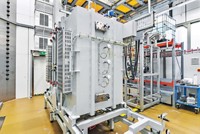Advertisement
Grab your lab coat. Let's get started
Welcome!
Welcome!
Create an account below to get 6 C&EN articles per month, receive newsletters and more - all free.
It seems this is your first time logging in online. Please enter the following information to continue.
As an ACS member you automatically get access to this site. All we need is few more details to create your reading experience.
Not you? Sign in with a different account.
Not you? Sign in with a different account.
ERROR 1
ERROR 1
ERROR 2
ERROR 2
ERROR 2
ERROR 2
ERROR 2
Password and Confirm password must match.
If you have an ACS member number, please enter it here so we can link this account to your membership. (optional)
ERROR 2
ACS values your privacy. By submitting your information, you are gaining access to C&EN and subscribing to our weekly newsletter. We use the information you provide to make your reading experience better, and we will never sell your data to third party members.
Petrochemicals
Dow wants small nuclear reactors to power US plant
Plan is part of chemical maker’s effort to reduce carbon emissions
by Matt Blois
August 11, 2022
| A version of this story appeared in
Volume 100, Issue 28

In its quest to cut carbon emissions, the chemical giant Dow wants to try something new: using small, modular nuclear reactors to power one of its plants on the US Gulf Coast.
Dow, which in the past has hinted at its interest in nuclear power, says it is partnering on the project with X-energy, a company developing gas-cooled nuclear reactors. Dow hopes that the reactors will be providing process heat and power to one of its facilities by about 2030.
The project would be a first for a manufacturing company, Dow says. The company is also taking an equity stake in X-energy, which expects to commission its first reactors in Washington State by 2027 as part of a US Department of Energy demonstration program.
The initiative is part of a push by Dow and other major companies to reduce carbon emissions in the chemical and plastics sectors. Dow is already planning to use carbon capture to create the world’s first carbon-neutral ethylene cracker, at a site in Alberta. Meanwhile, Clariant and Linde are trying to develop an entirely new method of ethylene production that uses catalysts in an oxidative ethane dehydrogenation process that promises lower carbon emissions.
Dow and Shell are also testing electric cracking furnaces that could run on renewable power. Robert Kumpf, who focuses on the chemical industry as an executive at the consulting firm Deloitte, says such electric furnaces would operate 24 h a day, making it difficult to use intermittent energy sources like wind or solar. In contrast, nuclear power is available continuously.
“For the chemical industry, we need 24/7 electrons,” Kumpf says. “That leads you to nuclear.”
Arij van Berkel, an analyst covering the energy transition for Lux Research, says he’s sure other large chemical companies are also considering nuclear power. He says electric crackers would need a large amount of power in one location. Nuclear reactors provide that centralized power better than wind or solar power facilities, which tend to be more geographically distributed. In addition, van Berkel says, X-energy’s gas-cooled reactors would get hot enough to provide useful heat for chemical companies.
Kumpf says storing wind or solar energy in batteries or by making hydrogen could be other options for securing continuous emission-free power, but right now they are very expensive.
In a 2021 analysis, Kumpf and his Deloitte colleague David Yankovitz identified nuclear power—along with hydrogen production, carbon capture, and other options—as one of the 15 best methods for reducing carbon emissions in the chemical industry. The list also includes strategies like producing chemicals by fermentation and advanced plastics recycling, which could reduce the amount of fossil fuel feedstock that crackers need. Yankovitz says the industry should be looking at all of them.
“There’s really not one silver bullet,” he says. “It’s going to take a portfolio to go after the lowering of emissions across the industry.”




Join the conversation
Contact the reporter
Submit a Letter to the Editor for publication
Engage with us on Twitter